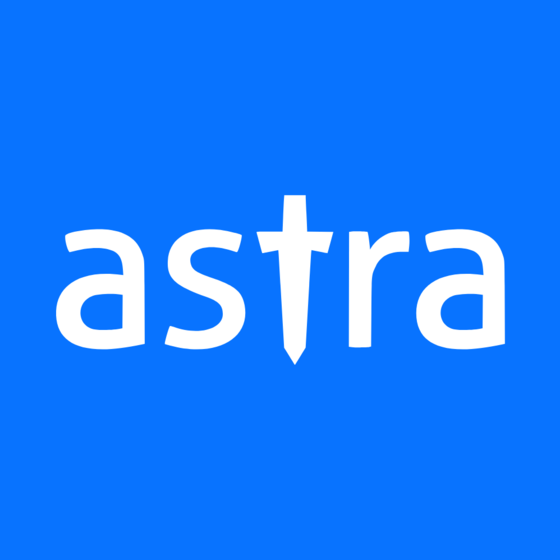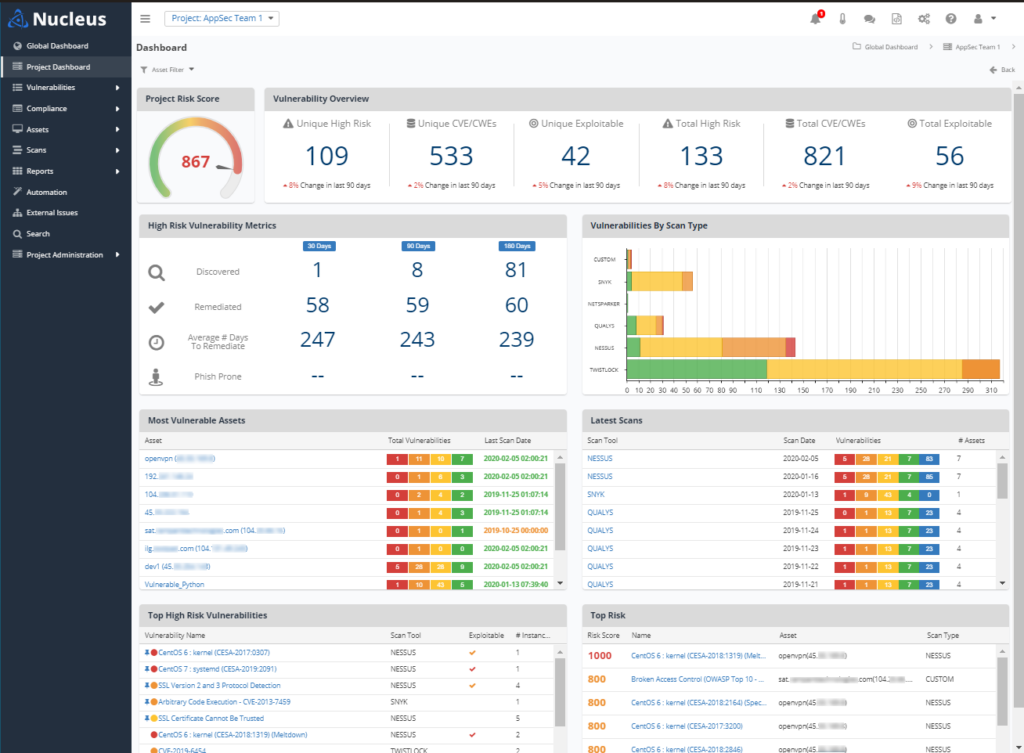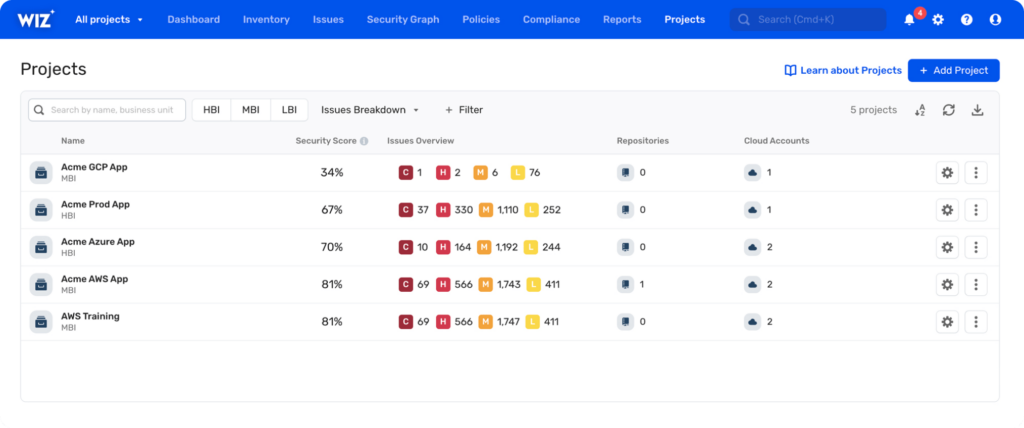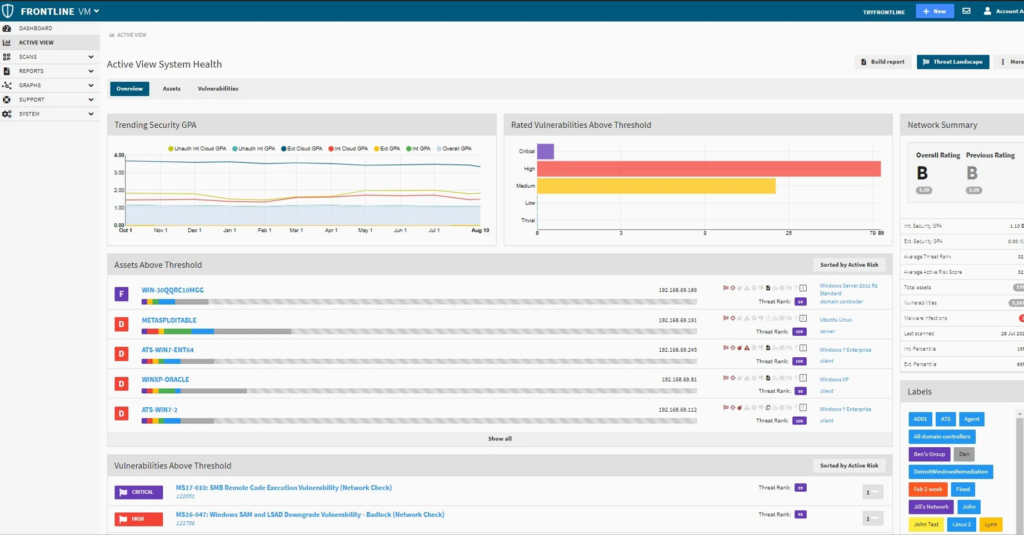10 Best Vulnerability Management Tools Shortlist
Here's my pick of the 10 best software from the 27 tools reviewed.
Our one-on-one guidance will help you find the perfect fit.
Vulnerability management tools are essential in securing digital assets, as they allow security teams to detect and manage vulnerabilities ranging from misconfigurations in operating systems to zero-day vulnerabilities targeted by hackers. These tools, leveraging open source technologies, APIs, and advanced penetration testing (pentest) techniques, guard against ransomware and malware by scanning infrastructure, including routers, SaaS applications, and firewalls, and cross-referencing with a vulnerability database.
They facilitate lifecycle management of vulnerabilities, alerting attack surface management, aiding in mitigation, and minimizing false positives. They're key in the race of web application security against hackers, providing customizable and configuration management features to suit unique environments. These tools offer a promising solution if you're navigating the complex waters of CVEs.
What is a Vulnerability Management Tool?
A vulnerability management tool is a software solution designed to identify, assess, track, and address security vulnerabilities within an organization's digital infrastructure. These tools are integral to the information security framework, providing valuable insights to fortify cyber defenses. IT professionals, security analysts, and cybersecurity teams commonly use them to mitigate potential threats and maintain optimal system security.
These tools help organizations proactively tackle cyber threats by scanning, detect vulnerabilities, having SIEM solutions, and ensuring critical information assets' integrity, confidentiality, and availability. In an era marked by increasing digital threats, these antivirus tools play a pivotal role in a robust cybersecurity strategy.
Best Vulnerability Management Tools Summary
| Tools | Price | |
|---|---|---|
| Astra Pentest | From $199/month | Website |
| Nucleus | From $99/month | Website |
| InsightVM (Nexpose) | Pricing upon request | Website |
| Wiz Vulnerability Management | Pricing upon request | Website |
| Arctic Wolf | Pricing upon request | Website |
| Frontline Vulnerability Manager | Pricing upon request | Website |
| IBM Security QRadar EDR | Pricing upon request | Website |
| Qualys VMDR | Pricing upon request | Website |
| Tenable Vulnerability Management | From $3/user/month (billed annually) | Website |
| Cisco Vulnerability Management | Pricing upon request | Website |
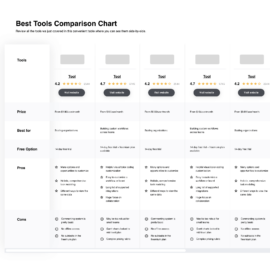
Compare Software Specs Side by Side
Use our comparison chart to review and evaluate software specs side-by-side.
Compare SoftwareBest Vulnerability Management Tools Reviews
Astra Pentest is a comprehensive security tool designed to perform thorough penetration testing across various platforms, including web applications, cloud environments, mobile apps, APIs, networks, and blockchain systems. It helps users identify vulnerabilities using an intelligent scanner and a user-friendly dashboard, ensuring robust web application security.
Why I Picked Astra Pentest: One of its key features is the vulnerability scanner, which performs over 8000 tests, including checks for known CVEs, OWASP Top 10, and SANS 25. This scanner is designed to cover every possible loophole, ensuring thorough security assessments. Additionally, the scanner can analyze pages behind login screens using a browser extension, which simplifies the process of securing every part of an application.
Standout features & integrations:
Some key features of Astra Pentest include pentests for web apps, cloud security, mobile apps, API, network security, and blockchain. It also offers reporting, compliance, and publically verifiable security certificates.
Integrations include GitLab, GitHub, Bitbucket, Slack, Jira, Microsoft Azure, Jenkins, CircleCI.
Pros and cons
Pros:
- User-friendly interface
- Comprehensive security checks for compliance
- Centralized dashboard for managing vulnerabilities
Cons:
- Limited customization options
- False positives are possible with the tool
Nucleus is a robust vulnerability management solution built to handle complex security environments. Its key strength lies in facilitating multi-framework compliance management, making it a unique player in vulnerability management.
Why I Picked Nucleus: Nucleus stands out for its ability to manage multi-framework compliance and consolidate data from various security tools. I chose Nucleus as the best for multi-framework compliance management since it's uniquely tailored to handle different security frameworks simultaneously, a feature that most other tools lack.
Standout features & integrations:
Some key features of Nucleus include risk-based vulnerability management and streamlined reporting. It also provides threat intelligence feeds to stay updated with emerging new vulnerabilities.
For integrations, Nucleus supports a wide range of security tools, including vulnerability scanners like Nessus, Burp Suite, and OWASP ZAP, allowing it to serve as a central hub for security data.
Pros and cons
Pros:
- Supports wide range of security tools
- Offers risk-based vulnerability management
- Facilitates multi-framework compliance management
Cons:
- Advanced features may require dedicated staff to manage effectively
- The user interface might be complex for beginners
- Pricing information not readily available
InsightVM, also known as Nexpose, is a vulnerability management tool by Rapid7 that offers real-time end-to-end visibility of your network. It performs live vulnerability scanning and provides prioritized risk data, making it a standout tool for visibility in real-time.
Why I Picked InsightVM (Nexpose): I picked InsightVM (Nexpose) because of its real-time visibility capabilities, an essential aspect for any organization striving for proactive security measures. Its ability to present a clear, live picture of the vulnerability landscape, and the prioritization of risk data, makes it unique among its peers. This is why InsightVM is an excellent tool for achieving real-time end-to-end visibility.
Standout features & integrations:
InsightVM excels with features such as live vulnerability scanning and risk-score prioritization. It also provides automated remediation workflows and reporting, allowing you to efficiently stay on top of vulnerabilities.
It integrates well with other Rapid7 tools and with an array of third-party apps, improving its effectiveness in a diverse tech ecosystem.
Pros and cons
Pros:
- Strong integrations with other tools
- Live vulnerability scanning
- Provides real-time end-to-end visibility
Cons:
- Some users report slow scanning times
- May have a steeper learning curve for beginners
- Pricing is not transparent
Wiz is a vulnerability management tool that provides security visibility across all multi-cloud environments. Its ability to analyze workloads, network data, and configurations makes it ideal for organizations operating in multi-cloud ecosystems.
Why I Picked Wiz Vulnerability Management: I chose Wiz for its holistic approach to multi-cloud security. It differentiates itself with its ability to provide visibility across all public clouds (AWS, GCP, Azure, and Oracle Cloud), even if multiple vendors manage them. Considering the increasing adoption of multi-cloud strategies, I determined that Wiz is the best option for multi-cloud environment security.
Standout features & integrations:
Wiz's notable features include comprehensive vulnerability scanning tools, advanced risk prioritization, and Cloud Security Posture Management (CSPM).
Furthermore, it offers robust integrations with popular DevOps tools such as Jira, Slack, and Microsoft Teams to streamline the vulnerability management workflow.
Pros and cons
Pros:
- Integrations with popular DevOps tools
- Advanced risk prioritization feature helps in effective vulnerability management
- Offers comprehensive visibility across multi-cloud environments
Cons:
- Dependence on integrations for workflow management may not suit all teams
- May have features that are too advanced or unnecessary for small businesses
- Lack of transparent pricing could be a deterrent for some potential users
Arctic Wolf is a risk-based vulnerability management service that helps prevent cyberattacks before they occur. Its services include monitoring, threat detection, and response, making it an excellent fit for businesses seeking comprehensive managed security services.
Why I Picked Arctic Wolf: I chose Arctic Wolf for this list because it specializes in Managed Detection and Response. This focus on MDR services sets it apart from generalist tools, making it an excellent choice for businesses that need specialized attention to security threats. The platform’s risk-scoring mechanism helps users determine the most mission-critical vulnerabilities. I believe Arctic Wolf is best for managed detection and response services.
Standout features & integrations:
Arctic Wolf's services include around-the-clock risk monitoring, threat hunting, and risk management. Moreover, it offers a cloud-native security platform,
Arctic Wolf Platform, which integrates well with existing IT infrastructure, making it easier for businesses to improve their security stance.
Pros and cons
Pros:
- Cloud-native platform integrates well with existing IT infrastructure
- Offers 24/7 monitoring and threat hunting
- Specializes in Managed Detection and Response
Cons:
- Less suitable for businesses looking for a simple, standalone tool
- Could be overkill for smaller organizations
- Pricing information is not transparent
Frontline Vulnerability Manager is a robust security solution designed to offer comprehensive vulnerability management. Its strength lies in providing excellent cloud and network security integration, making managing and securing hybrid infrastructures easier.
Why I Picked Frontline Vulnerability Manager: I selected Frontline Vulnerability Manager due to its powerful cloud and network security combination. Its ability to manage vulnerabilities across diverse infrastructure elements sets it apart. Therefore, for companies aiming for integrated cloud and network security, Frontline Vulnerability Manager is an ideal choice.
Standout features & integrations:
Frontline Vulnerability Manager offers high-speed discovery, prioritized vulnerabilities, and remediation workflow automation.
It also stands out for its integration with a wide range of cloud infrastructures like AWS, Azure, and Google Cloud, as well as various network devices, ensuring an encompassing security coverage.
Pros and cons
Pros:
- Robust discovery and remediation tools
- Prioritized vulnerabilities feature
- Strong cloud and network integration
Cons:
- Some users report complex setup procedures
- Might be overkill for smaller businesses
- Pricing information is not readily available
The IBM Security QRadar EDR tool is an advanced threat protection platform that provides companies with critical insight into potential security risks. Its capabilities are uniquely designed for comprehensive threat intelligence, providing a holistic view of a firm's threat landscape.
Why I Picked IBM Security QRadar EDR: In the realm of cybersecurity tools, IBM Security QRadar EDR emerged as a top pick for me because of its capability to offer end-to-end threat detection and response. This tool has top-notch threat intelligence that goes beyond others. It gathers and analyzes data from multiple sources for a complete view of security risks.
Standout features & integrations:
IBM Security QRadar EDR shines with features like artificial intelligence (AI) integration, which supports advanced threat detection and automated response actions. Furthermore, it’s User Behavior Analytics (UBA) helps identify insider threats by analyzing patterns.
Notably, QRadar EDR integrates well with other security and IT management platforms, allowing for streamlined threat management.
Pros and cons
Pros:
- Facilitates robust user behavior analysis
- Provides advanced threat detection with AI
- Offers comprehensive threat intelligence
Cons:
- Advanced features may require dedicated personnel to manage
- May be complex for new users
- Pricing not readily available
Qualys VMDR (Vulnerability Management, Detection, and Response) is a cloud-based solution offering a unified IT security and compliance approach. Combining asset discovery and inventory with vulnerability assessment tools is perfect for complete IT asset management.
Why I Picked Qualys VMDR: I selected Qualys VMDR because it offers a full-featured platform, merging IT asset management with vulnerability detection. This tool combines inventory and vulnerability assessment to offer a thorough approach to asset management. It detects all IoT, OT, and IT assets for a complete inventory. This includes your on-premises device and application, certificate, cloud, container, and mobile device inventory. This makes Qualys VMDR best for comprehensive IT asset management.
Standout features & integrations:
Qualys VMDR's core features include IT asset discovery, inventory management, patch management, continuous monitoring, and vulnerability assessment.
Furthermore, the tool provides robust integrations with common enterprise platforms such as ServiceNow, Splunk, JIRA, and Microsoft Cloud solutions.
Pros and cons
Pros:
- Continuous monitoring and risk assessment
- Wide range of integrations with enterprise platforms
- Comprehensive approach to asset management and vulnerability assessment
Cons:
- The tool's broad scope may introduce complexity for some users
- Pricing could be high for smaller organizations
- Annual pricing model may not suit all businesses
Best for active directory and infrastructure security
Tenable Vulnerability Management is a comprehensive security platform that provides a thorough active directory and infrastructure security. It allows organizations to continuously monitor their IT infrastructure, ensuring security weaknesses are promptly identified and addressed, which aligns perfectly with its 'best for' statement.
Why I Picked Tenable Vulnerability Management: I picked Tenable for its strong emphasis on active directory and infrastructure security. Its robustness in these areas sets it apart from many other tools. If active directory and infrastructure security are your priority, then Tenable Vulnerability Management is the right choice.
Standout features & integrations:
Tenable Vulnerability Management offers predictive prioritization, continuous visibility, and in-depth analytics among its most essential features.
Regarding integrations, it connects with a wide range of systems, including Active Directory, cloud-based infrastructures, and a variety of networking equipment, adding to its value in managing infrastructure security.
Pros and cons
Pros:
- Provides continuous visibility and in-depth analytics
- Offers predictive prioritization of vulnerabilities
- Excellent for Active Directory and infrastructure security
Cons:
- Depending on the scale, deployment might require significant resources
- Interface can be complex for new users
- Pricing details are not readily available
Cisco Vulnerability Management is a robust security solution that offers an expansive range of device and protocol coverage. The tool scans your network to identify and manage vulnerabilities, making it an excellent choice for those seeking to secure diverse device environments and protocols.
Why I Picked Cisco Vulnerability Management: I chose Cisco Vulnerability Management primarily because of its wide device and protocol coverage, which is critical for businesses operating in a mixed environment. I determined this tool to be unique in its capability to cover many devices and protocols, making it best for organizations that utilize the diverse technological infrastructure.
Standout features & integrations:
Key features of Cisco Vulnerability Management include robust scanning capabilities, extensive device and protocol support, and advanced reporting.
Its integrations are also impressive, with connectivity to other Cisco security products and third-party security systems, broadening its utility and effectiveness within your security ecosystem.
Pros and cons
Pros:
- Integration with Cisco and third-party security systems
- Advanced reporting capabilities
- Extensive device and protocol coverage
Cons:
- Limited customization features for reporting and dashboards
- May have a steep learning curve for new users
- Pricing details are not readily available
Other Vulnerability Management Tools
Below is a list of additional legal practice management software that I shortlisted, but did not make it to the top 12. Definitely worth checking them out.
- Adlumin
Best for financial sector-focused security
- Microsoft Defender Vulnerability Management
Best for integration with Microsoft ecosystem
- CYRISMA
Best for intuitive user interface and automated patching
- SanerNow
Good for combined vulnerability management and patch remediation
- ManageEngine Vulnerability Manager Plus
Good for unified vulnerability management and patching
- Resolver
Good for integrating risk management across business operations
- HostedScan
Good for providing quick and easy external vulnerability scans
- Syxsense
Good for real-time endpoint management and security
- Argos Threat Intelligence Platform
Good for proactive and personalized threat intelligence
- ServiceNow Security Operations
Good for security incident response and vulnerability response workflows
- KernelCare Enterprise
Good for automatic, live patching without rebooting
- CODA Footprint
Good for providing Azure-focused compliance assessments
- Aqua Security
Good for cloud-native application protection
- Brinqa
Good for risk-based vulnerability management
- Continuity Software
Good for business continuity planning and incident management
- Endgescan
Good for full-stack vulnerability management with AI validation
- VulScan
Good for comprehensive internal and external vulnerability scanning
Selection Criteria for Vulnerability Management Tools
While selecting the best vulnerability management tools, I've personally tried and tested an extensive range of these software solutions. From my research, the following criteria stood out as the most essential when determining the effectiveness and suitability of each tool.
Core Functionality:
Vulnerability management tools should enable users to:
- Scan and identify vulnerabilities in their systems.
- Prioritize vulnerabilities based on severity and risk.
- Automate remediation processes where possible.
- Maintain compliance with industry-specific regulations (HIPAA, DSS, PCI, etc.).
- Generate detailed reports for transparency and accountability.
Key Features:
The key features to look out for in a vulnerability management tool include:
- Automated Scans: Regular, automated vulnerability scans to ensure continuous security monitoring.
- Risk-Based Prioritization: This feature prioritizes vulnerabilities based on the risk they pose, helping teams focus their efforts efficiently.
- Remediation Automation: Tools that can automate the process of patching vulnerabilities save valuable time and resources.
- Compliance Management: Many industries require compliance with specific security benchmarks. A tool that can help manage and maintain this compliance is invaluable.
- Detailed Reporting: Detailed and comprehensive reports provide insight into a system's security posture and demonstrate due diligence.
Usability:
The design and user experience of vulnerability management tools plays a crucial role in their effectiveness. In this context, important aspects include:
- Intuitive Dashboard: The tool should have a central dashboard that provides a comprehensive overview of the system's security status, including identified vulnerabilities, their severity, and remediation status.
- Easy Onboarding: Considering the complex nature of vulnerability management, tools should provide clear guidance and resources for new users to get up to speed quickly.
- Role-based Access: Different team members have different responsibilities in the vulnerability management process. A tool should enable easy configuration of access and permissions based on roles.
- Quality Customer Support: Given the critical nature of vulnerability management, robust customer support is crucial. Support should be easily accessible, responsive, and capable of resolving issues promptly.
Most Common Questions Regarding Vulnerability Management Tools (FAQ’s)
What are the benefits of using vulnerability management tools?
Vulnerability management tools offer numerous advantages, including:
- Improved Security: These tools continuously monitor and identify potential vulnerabilities in your systems, thus strengthening your security posture.
- Efficiency: Automated scans and remediation processes make vulnerability management more efficient, saving your IT team valuable time.
- Compliance: Many industries have strict regulatory requirements regarding data security. Vulnerability management tools help ensure compliance with these regulations.
- Proactive Approach: Instead of responding to breaches after they occur, vulnerability management tools allow for a proactive approach, identifying and patching vulnerabilities before they can be exploited.
- Detailed Reporting: These tools often include robust reporting capabilities, providing insight into your security posture and making it easier to demonstrate due diligence.
How much do vulnerability management tools typically cost?
The pricing for vulnerability management tools can vary significantly based on the scale of your operations, the features you require, and the specific tool you choose. Generally, the price is often based on a per-user or per-asset model.
What are the typical pricing models for vulnerability management tools?
Most vulnerability management tools follow one of these pricing models:
- Per User/Per Asset: This is the most common pricing model, where you pay based on the number of users or assets you need to manage.
- Subscription: Some tools offer monthly or annual subscriptions, including access to all features and updates.
- Free with Limited Features: Some tools offer a free version with limited capabilities, often aimed at small businesses or individual use.
What is the typical range of pricing for vulnerability management tools?
The pricing can range from as low as $10 per user/month to $100s per user/month for enterprise-scale solutions with extensive features. The price can also significantly increase depending on the number of assets being managed.
Which are the cheapest and most expensive vulnerability management tools?
The cheapest tools generally offer a free version with limited capabilities, like OpenVAS. The most expensive ones are typically enterprise-grade tools with extensive features and capabilities, such as Qualys VMDR or Rapid7 InsightVM.
Are there any free vulnerability management tools?
Yes, several free tools are available, especially for smaller-scale use or individual users. Tools such as OpenVAS and Microsoft Baseline Security Analyzer offer free versions, albeit with limited capabilities compared to their paid counterparts. These can be good starting points for small businesses or those with a tight budget.
More Vulnerability Management Tools-Related Reviews
- Infrastructure Automation Tools
- Privileged Access Management Solutions
- Software Composition Analysis Tools
Summary
Choosing the right vulnerability management tool involves careful consideration of several factors. It's essential to focus on the tool's core functionality, ensuring it can identify, prioritize, and help remediate vulnerabilities efficiently while keeping you in line with compliance regulations. Key features such as automated scans, risk-based prioritization, remediation automation, compliance management, and detailed reporting also play a crucial role in determining the tool's effectiveness.
Finally, usability factors, including an intuitive dashboard, easy onboarding, role-based access, and quality customer support, significantly impact the overall user experience and tool efficiency.
Here are three key takeaways from this buyer's guide:
- Define Your Requirements: Understand your specific needs, industry-specific regulations, and the scale at which you'll implement the tool. This will help you narrow down the choices.
- Focus on Usability: A tool may have all the features, but if it's hard to use, it will hinder your vulnerability management process. Ensure the device has an intuitive interface, an easy onboarding process, and offers quality customer support.
- Consider the Pricing: Pricing models vary across different tools. Consider the tool's price in the context of its features and your budget. Some tools may offer a free version or a trial period which can be useful to assess the tool before committing.
What do you think?
I hope this guide helps you find your organization's right vulnerability management tool. However, the cybersecurity landscape is vast and continuously evolving.
If you know of a tool that should be on this list, or if you've had a different experience with any of the tools mentioned, please feel free to share your thoughts. I appreciate your contributions to making this resource as accurate and helpful as possible.

